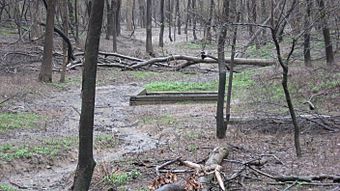Illinois Salines facts for kids
Quick facts for kids |
|
|
Illinois Salines
|
|
 |
|
| Nearest city | Equality, Illinois |
|---|---|
| Area | 306 acres (124 ha) |
| NRHP reference No. | 73000702 |
| Added to NRHP | May 24, 1973 |
The Illinois Salines, also known as the Saline Springs or Great Salt Springs, is a special place in Gallatin County, Illinois. It is located along the Saline River. For thousands of years, this site was a very important source of salt. Long ago, people living in Illinois used these springs to get the salt they needed. Later, after Europeans arrived, the salt springs became Illinois' first big industry. It's also a unique historical site because it was one of the few places in Illinois where slavery was allowed for a time, even after Illinois became a state.
Ancient History of the Salt Springs
The Illinois Salines were a super important source of salt for the people who lived in Illinois long, long ago. Scientists think people first started using this site during the Early Woodland Period. They continued to use it all the way through the Mississippian period.
The salt dug up from this site was traded to other ancient communities in Illinois. We know this because items from the Saline Springs have been found at the Kincaid Site. This site is located at the very southern tip of Illinois. The Saline Springs are also important because they hold many ancient remains. These include things like shells, bones, and other natural materials.
Archaeologists started digging at the site in the mid-1800s. These digs have continued throughout the 1900s. A special archaeology project from Southern Illinois University has been studying the site since 1981.
Salt Production in Later Years
After Europeans settled in the area, the southern Illinois salines became the first major industry in the Illinois Territory. At the salines, salty water (called brine) was boiled down to make salt. This was a very successful business. When Illinois became a state in 1818, the salt springs became property of the state.
Even though Illinois was generally a free state, a special rule was made in the Illinois Constitution. This rule allowed slavery at the Illinois Salines and other salt springs near Shawneetown. This exception was made because the salt produced by enslaved workers brought in a lot of money. It contributed about one-third of the new state's yearly income.
The law allowed enslaved African workers to be brought to the site until 1825. After this, the special rule ended. However, other forms of forced labor, like indentured servitude, continued at the springs even after this date. Salt production kept going until 1870. At that time, salt from mines in West Virginia became cheaper. This competition caused the Illinois Salines to go out of business.
The Illinois Salines site was added to the National Register of Historic Places on May 24, 1973.



